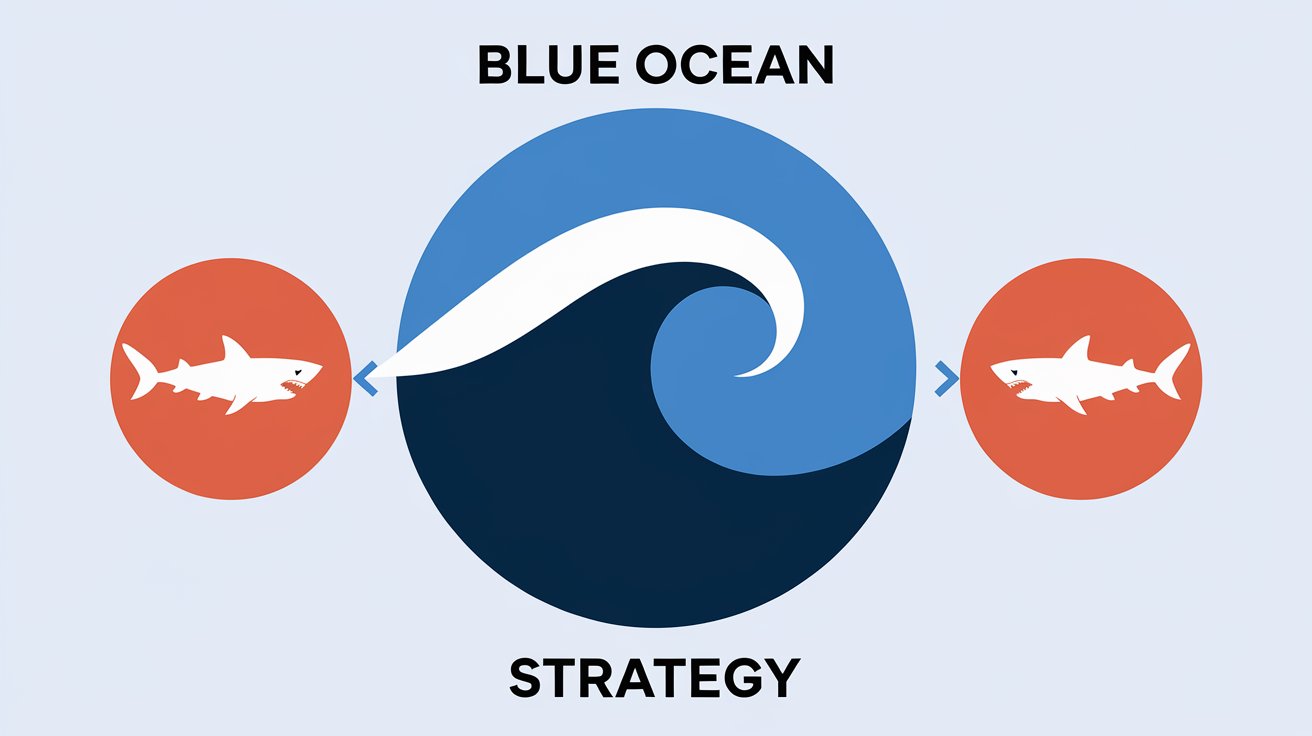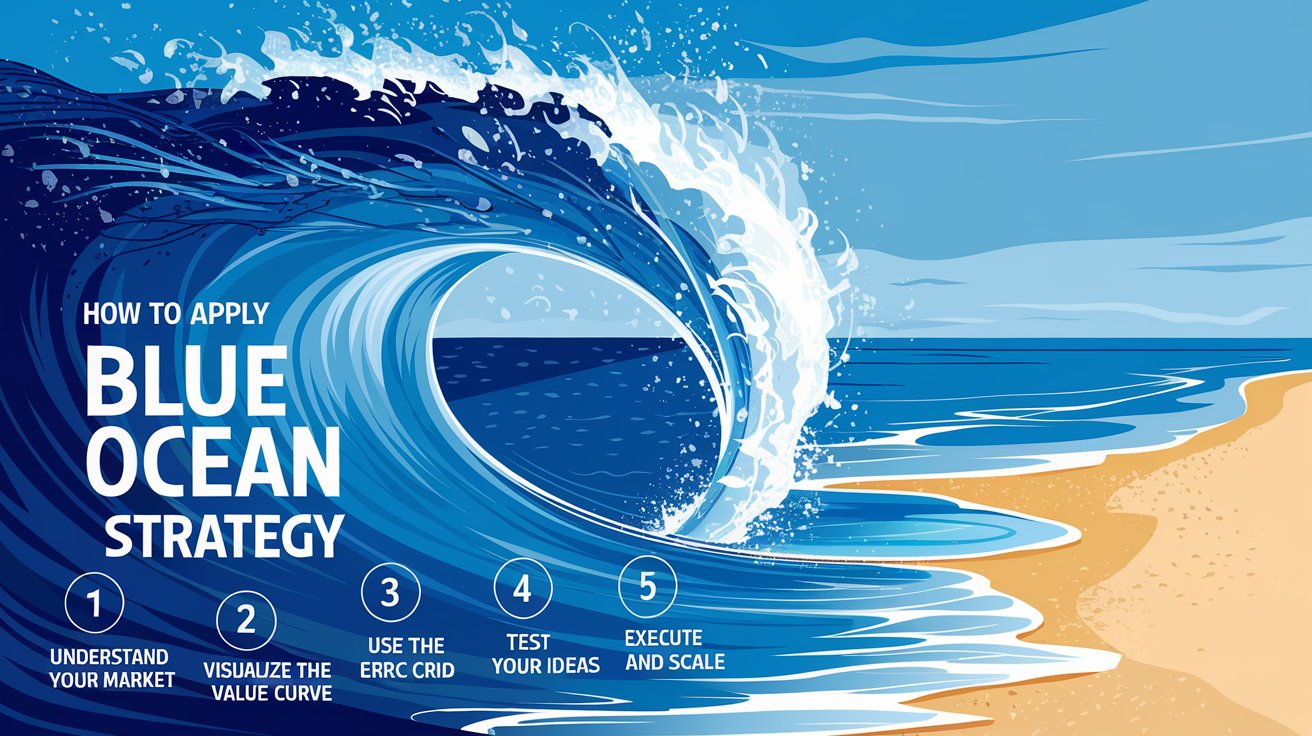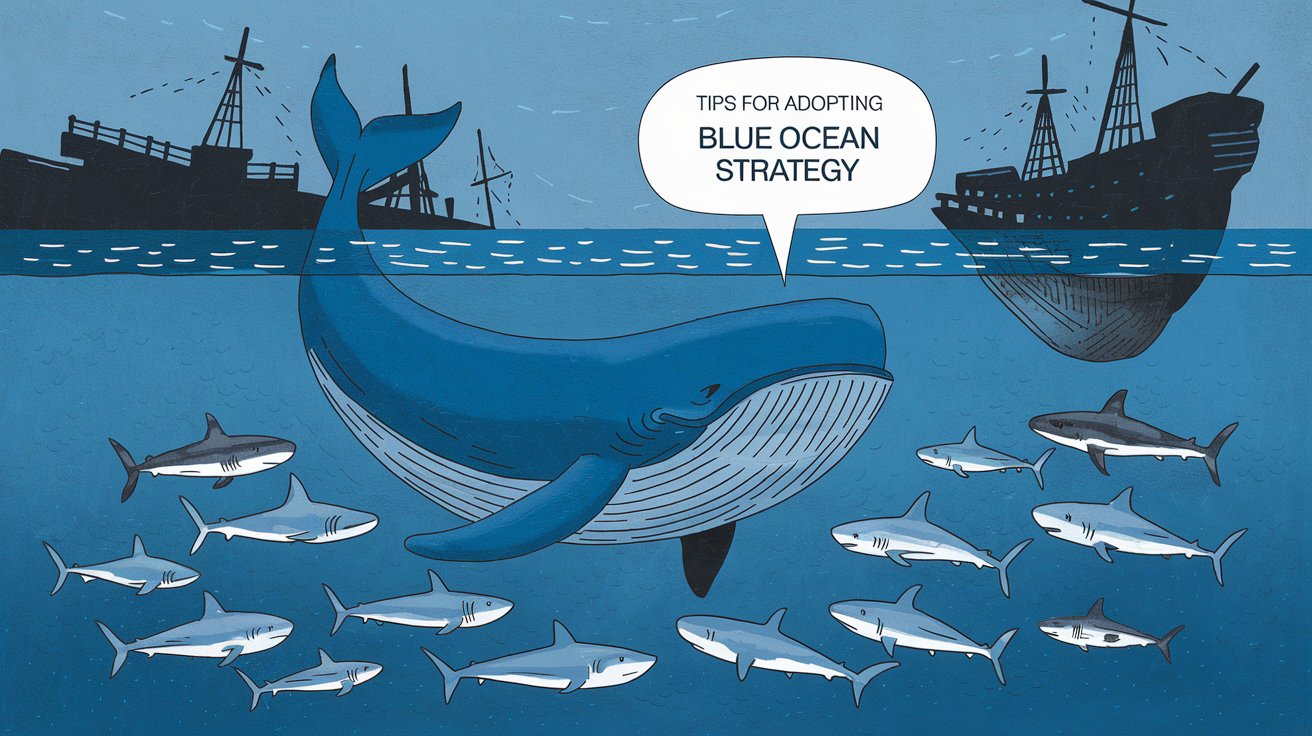How Can Businesses Use Blue Ocean Strategy to Create Untapped Market Opportunities?

Tired of fighting competitors? Here’s how to break free and win new markets!
A space where only your business can lead with no competitors!
Yes, you heard that right! That’s exactly what the Blue Ocean Strategy can help you achieve.
This strategy helps businesses by making their uniqueness into a competition in which no rivals can compete. It focuses on finding unused opportunities instead of battling rivals in overcrowded markets. It creates new demand and makes competition irrelevant.
Here, you will explore the powerful approach of the blue ocean strategy. And, how it unlocks new ways to grow with real-life examples. We will also guide you on your journey to explore your “blue ocean” and leave the competition behind.
What Is the Blue Ocean Strategy?
The Blue Ocean Strategy is the total opposite of the “Red Ocean” approach. An approach where companies compete aggressively for a slice of the existing market. W. Chan Kim and Renée Mauborgne introduced this strategy in their groundbreaking book, which focuses on creating uncontested market space.
Here’s the difference:

Red Ocean | Blue Ocean |
Fierce competition over demand. | Creating new demand. |
Focus on beating rivals. | Focus on innovation and value. |
Saturated markets. | Unexplored, untapped markets. |
Examples of Blue Ocean Companies:
- Cirque du Soleil: “Circus of the Sun”, a Canadian entertainment company, revolutionized the circus by blending it with theater, appealing to a broader audience.
- Tesla: Transformed electric vehicles from niche to luxury, creating an entirely new market.
These companies didn’t compete within existing boundaries; they redefined the game altogether.
Why Should You Adopt the Blue Ocean Strategy?
The Blue Ocean Strategy offers many benefits for businesses. It helps you focus on opportunities that your competitors may have missed. Here’s why it’s a great choice:
Discover New Customers:
This strategy helps you find untapped markets. These are places where your competitors are not active. It allows you to attract new customers and grow your business.
No Competition Stress:
You don’t have to fight for the same customers as everyone else. Instead, you operate in spaces where you are the only leader. This reduces the pressure of competing.
Encourage Innovation:
It inspires you to think differently. You can create new products or services that solve problems in unique ways. This makes your business stand out.
Enjoy Higher Profits:
When you offer something unique, customers are often willing to pay more. This increases your profit margins and ensures long-term growth.
A study by the Harvard Business Review found that businesses using the Blue Ocean Strategy grew 3-4 times faster than their competitors over 10 years. This proves the power of focusing on untapped opportunities.
How to Apply Blue Ocean Strategy in Your Business:

Want to make this strategy work for you? Follow these actionable steps:
Understand Your Market:
Understand your market by researching your industry thoroughly. Identify “Red Oceans” where competition is fierce. Then, Look for gaps in customer needs that no one is addressing.
Visualize the Value Curve:
Use the strategy canvas to understand how competitors deliver value and spot opportunities to innovate and differentiate.
Use the ERRC Grid:
This powerful tool helps you reshape your offering by focusing on four elements:
- Eliminate: Remove features customers don’t care about.
- Reduce: Cut costs by simplifying unnecessary elements.
- Raise: Improve factors that enhance customer experience.
- Create: Introduce something completely new that sets you apart.
For example, Uber eliminated the hassle of traditional taxi services, reduced waiting times, raised convenience through technology, and created an on-demand transportation experience.
Test Your Ideas:
Test your ideas by launching small-scale pilots to gauge customer interest. Also, collect feedback to refine your offering.
Execute and Scale:
After testing, roll out your strategy on a larger scale. Stay flexible and adjust based on market response.
For more strategies, check out What is the Blue Ocean Strategy? It’s a great resource to help you understand and apply the basics effectively.
Real-Life Success Stories of Blue Ocean Strategy:
Southwest Airlines:
They simplified air travel by focusing on affordability and efficiency while cutting out unnecessary luxuries like in-flight meals. This attracted budget-conscious travelers and opened a new market.
Square:
Using the blue ocean strategy, Square empowered small businesses with mobile payment solutions, creating a new category of financial services.
Nintendo Wii:
Nintendo Wii used a blue ocean strategy by targeting non-gamers by offering easy-to-use motion-controlled games, carving out a unique space in the gaming industry.
Challenges You May Face:
The Blue Ocean Strategy is powerful, but it does come with challenges. Understanding these hurdles will help you prepare better.
Resistance to Change:
- Many teams find it hard to move away from what they know. They may prefer sticking to tried-and-true methods.
- Convince them to try something new but it can be difficult.
Initial Costs:
- Innovation often requires investment. This can feel risky, especially in the beginning.
- You might need to spend on research, testing, or developing new ideas.
Market Uncertainty:
- Unexplored markets can be unpredictable.
- Since they are new, there’s no clear roadmap to follow. You may face unexpected challenges or delays.
Competitor Imitation:
- Once your idea is successful, competitors may copy it.
- They might try to enter the same market and take away some of your share.
To deal with these challenges, stay focused on your goals. Balance creativity with practicality. Keep listening to your customers and adapting your approach based on their needs. This will help you stay ahead even in uncertain situations.
Tools to Make Blue Ocean Strategy Easier:
Here are some tools that can help you successfully implement this strategy:
Strategy Canvas:
Compare your value offerings with competitors to find untapped opportunities.
ERRC Framework:
Reshape your product or service based on customer needs.
Pioneer-Migrator-Settler Map:
Focus on “pioneering” ideas that can lead to the most significant market breakthroughs.
These tools simplify the process of exploring and capturing new markets.
Tips for Adopting Blue Ocean Strategy:

Here are some tips for adopting the blue ocean strategy.
- Encourage a culture of innovation across your organization.
- Involve cross-functional teams to brainstorm unique ideas.
- Stay customer-focused by understanding their unmet needs.
- Keep an eye on market trends to identify emerging opportunities.
Conclusion:
To sum up, the Blue Ocean is a strategy that is used to create a separate market space for the business. The spaces in which there is no competition. These spaces are only led by the business that applied the strategy.
Businesses can create new demands and fulfill them through their unique methods. This will help them create new market spaces and lead them. Now, there is no need to compete in a crowded market. You can just use the Blue Ocean strategy and eliminate all the competitors.
Want consultation for creating your own Blue Ocean strategy? Contact HubDigit for more details and make your brand unique in the market.
